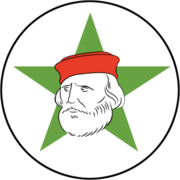Popular Democratic Front (Italy)
 From Wikipedia the free encyclopedia
From Wikipedia the free encyclopedia
Popular Democratic Front Fronte Democratico Popolare | |
|---|---|
 | |
| Leaders | Palmiro Togliatti Pietro Nenni |
| Founded | 28 December 1947 |
| Dissolved | 18 April 1948 |
| Ideology | Communism Socialism |
| Political position | Left-wing |
| Colours | Red |
The Popular Democratic Front (Italian: Fronte Democratico Popolare), shortened name of the Popular Democratic Front for Freedom, Peace, Labour (Italian: Fronte Democratico Popolare per la libertà, la pace, il lavoro), was a left-wing political coalition in Italy.[1][2] Formed in December 1947 by the Italian Socialist Party (PSI) and the Italian Communist Party (PCI),[3][4][5] it contested the 1948 Italian general election.[6]
History[edit]
The coalition was formed for the 1948 general election and consisted of the PSI and PCI. Its symbol was a green star surmounted by an image of Italian unification hero Giuseppe Garibaldi.[7] The Social Christian Party (PCS) and Sardinian Action Party (PSd'Az) were not allied with the coalition, and formed their own electoral lists. The right-wing of the PSI opposed the coalition, and left the party and organised a separate list as Socialist Unity; this group later became the Italian Democratic Socialist Party (PSDI). The election of 1948 was perhaps the most important in the history of the Italian Republic, as the choice of future alliance with United States or with the Soviet Union was at issue. The coalition got 31.0% of the vote for the Italy's Chamber of Deputies and 30.8% of the country's Senate of the Republic vote.[8]
Following the victory of Christian Democracy (DC) with 48.5%, Italy became a founding member of NATO in 1949. After the electoral defeat, while the PCI and PSI remained allies at the national level until 1956 and would govern together at the local level into the 1990s, the coalition was dissolved. Despite the loss, the PCI established itself as the main opposition to the DC and went on to become the largest Communist party in Western Europe.[9]
Composition[edit]
| Party | Ideology | Leader | |
|---|---|---|---|
| Italian Communist Party (PCI) | Communism Marxism–Leninism | Palmiro Togliatti | |
| Italian Socialist Party (PSI) | Democratic socialism Social democracy | Pietro Nenni | |
Election results[edit]

| Chamber of Deputies | |||||
| Election year | Votes | % | Seats | +/− | Leader |
|---|---|---|---|---|---|
| 1948 | 8,136,637 (2nd) | 31.0 | 183 / 574 | – | |
| Senate of the Republic | |||||
| Election year | Votes | % | Seats | +/− | Leader |
|---|---|---|---|---|---|
| 1948 | 6,969,122 (2nd) | 30.8 | 72 / 237 | – | |
References[edit]
- ^ Gori, Francesca; Gons, Silvio (1963). Aggiornamenti sociali (in Italian). Vol. 14. p. 217.
- ^ Fedele, Santi (1978). Fronte popolare. La sinistra e le elezioni del 18 aprile 1948 (in Italian). Bompiani.
- ^ Cacciatore, Giuseppe (1979). La sinistra socialista nel dopoguerra. Meridionalismo e politica unitaria in Luigi Cacciatore (in Italian). Dedalo. pp. 2014–218. ISBN 978-8-8220-0347-8.
- ^ Gundle, Stephen (1995). I comunisti italiani tra Hollywood e Mosca. La sfida della cultura di massa 1943-1991. Giunti. p. 86. ISBN 978-8-8092-0642-7.
- ^ Gori, Francesca; Gons, Silvio (1998). Dagli archivi di Mosca. L'URSS, il Cominform e il PCI (1943-1951) (in Italian). Carocci. p. 83. ISBN 9788843010929.
- ^ Tobagi, Walter (2009). La rivoluzione impossibile. L'attentato a Togliatti, violenza politica e reazione popolare (in Italian). Il Saggiatore. p. 16. ISBN 978-8-8565-0112-4.
- ^ Belco, Victoria (2010). War, Massacre, and Recovery in Central Italy, 1943–1948. University of Toronto Press. p. 498. ISBN 978-0-8020-9314-1.
- ^ Mudambi, Ram; Navarra, Pietro; Sobbrio, Giuseppe (2001). "A History of the Italian Political System – 1913 to the Present". Rules, Choice and Strategy: The Political Economy of Italian Electoral Reform. Edward Elgar Publishing. pp. 32–33. ISBN 978-1-7819-5082-1.
- ^ SilverstrI, Fabio (April 2008). "Quel Fronte poco popolare". 30 Giorni (in Italian). No. 4. Retrieved 5 July 2023.